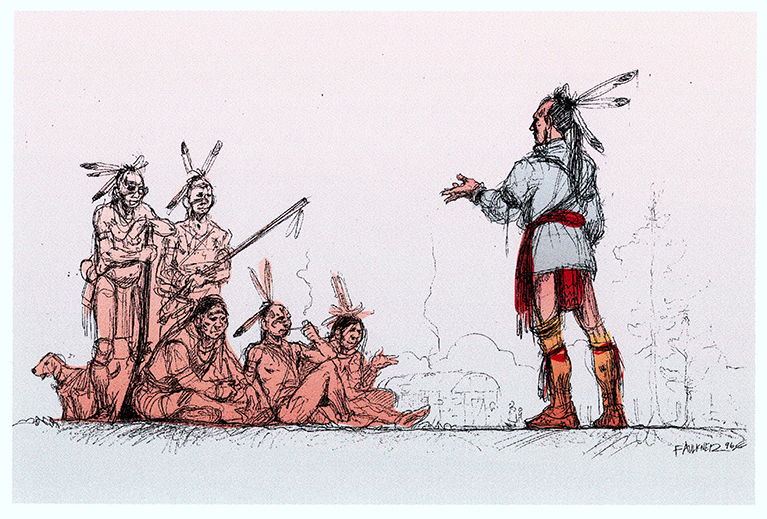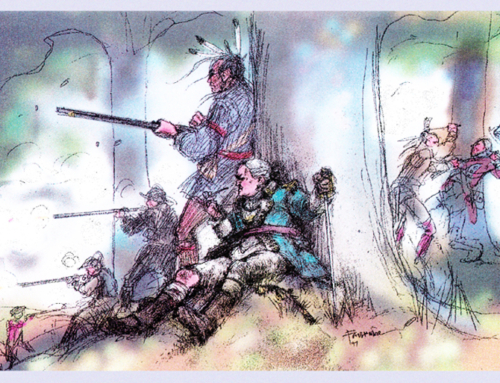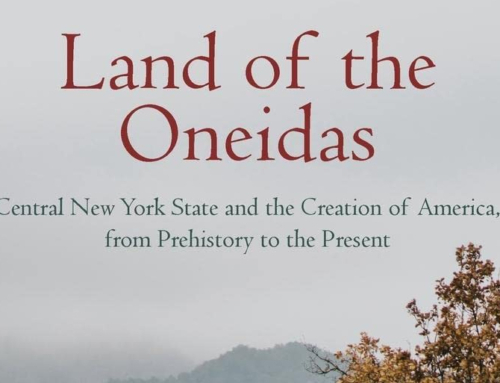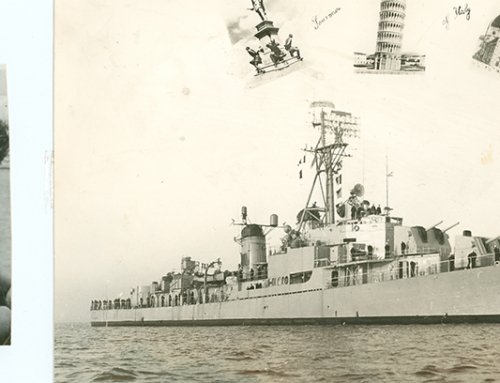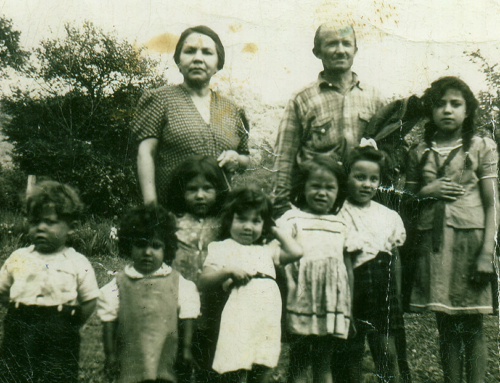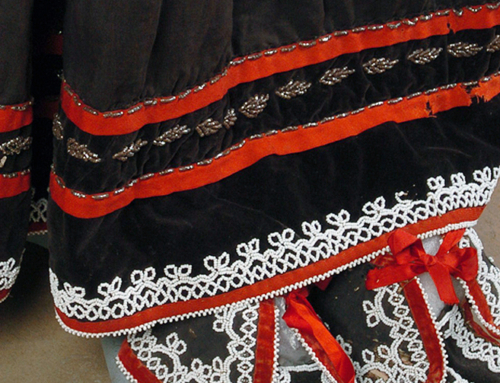When the tension between the American colonies and the British grew into armed conflict, the Haudenosaunee Confederacy tried at first to remain neutral and then to reach agreement on which side to support. Representatives of the six member Nations debated through several meetings of the Grand Council, many in favor of supporting the British, with whom the Confederacy had substantial trade relations, and a few – primarily the Oneidas – passionately on the side of the colonists. In the end, the Grand Council decided to let each Nation choose its own path in the conflict. The Oneida Indian Nation and some Tuscaroras joined with the colonists, becoming the young nation’s first allies and providing critical help on the battlefield and off.
Here are some of the people who played key roles in the Oneida Indian Nation’s destiny during the American Revolution:
Alawistonis, Jacob – “Hlau-istany”/ “Blacksmith”/ “Silversmith”
Alawistonis was a Traditionalist Warrior from the Wolf Clan and lived at Kanonwalohale. He was the nephew of Agwalongdongwas (Good Peter) and spoke at many conferences and meetings. He was a speaker at the September 1784 Fort Stanwix conference and signed the Fort Stanwix Treaty on September 22, 1788.
He was among the signers of the letter to Governor Clinton complaining about Lewis Cook’s pro-French influence over the Oneida Sachems on October 28, 1789.
Alawistonis also signed a letter to Governor Clinton demanding control over their own Oneida lands on January 27, 1790.
He was also a signer to the act regarding land appropriated by New York for use by the Oneida, Cayuga and Onondaga on April 19, 1793.
He was included in the 1794 war-losses statement of 1780 at Kanonwalohale.
Alawistonis was the Keeper of the Standing Stone in 1796 and he kept it right outside his home.
Alawistonis is credited with re-introducing the White Dog sacrifice ceremony in Kanonwalohale in the winter of 1799.
He was recognized within the Oneida Indian Nation as the leader of the Pagan Party in 1800.
Atayataghlonghta – “Lewis Cook”
Lewis Cook was a warrior of Mohawk/African descent who spoke English, Oneida, Mohawk and French, lived with the Oneidas and was adopted by Shenendoah as his son. He was born around 1740 and frequently visited Caughnawauga (Kanawake) but lived at Kanonwalohale.
As a Mohawk, he begrudgingly supported the British until 1775, but in August 1777 he volunteered to serve under Han Yerry at the Battle of Oriskany and proved his loyalty to the rebel cause.
Lewis was an excellent warrior and proved his bravery again when he led the Oneida fighters at the Battle of Saratoga in September 1777.
In April 1779, 12 Officer Commissions were given to the Oneidas to award to those Oneidas that had earned them. They chose 11 Oneidas and one Tuscarora to receive the commissions, completely forgetting about their Mohawk friend. A month later, Philip Schuyler was able to secure an additional commission, which he awarded to Lewis as a Lieutenant Colonel.
On October 28, 1789, a letter was written to Governor Clinton complaining about Lewis Cook’s pro-French influence over the Oneida sachems, and was signed by about 30 Oneidas. He married into a pro-French Oneida family in December 1790, and his standing in the community declined, although he did serve as a speaker at a meeting in Philadelphia in April 1792 regarding land ownership.
He was awarded land due to his involvement with the Oneida in the revolution in January 1791.
Hanonwayele, Mary – “Wale”
Wale was a Bear Clan Mother and the sister of Sachem Thomas Sinavis, who died at the Battle of Barren Hill in 1778. Wale became a Christian in her later years of life and lived at Kanonwalohale.
Wale’s first husband was Paul Otsetogon, who died in the late 1790’s. Wale then married Anthony Shononghliyo, a League Sachem for the Oneida.
Wale attended many meetings and conferences, but as a woman did not have much say in the proceedings. She signed the Fort Stanwix Treaty on September 22, 1788 and also signed the act regarding the appropriation of land by New York State for use by the Oneida, Onondaga and Cayuga on April 19, 1793.
Wale was also involved as a “matron” in Kirkland’s congregation on February 10, 1800.
Wale was included in the War-losses claim (of 1780) in 1794 at Kanonwalohale and was finally given compensation for the death of her brother Thomas almost 20 years later.
Han Yerry – (Tewahongalahkon) “He Who Takes Up the Snowshoe”
A member of the Wolf Clan, Han Yerry was a sachem who lived at Oriska and also later in life became a Head Warrior as a result of his fighting prowess. He was married to Two Kettles Together (Tyonajanegen) and had three children; Jacob, Cornelius and Dolly. Han Yerry received many commendations and awards throughout his lifetime, most notably, his being awarded a commission as Captain for his service during the Revolutionary War. Han Yerry, Two Kettles Together and their son Cornelius fought bravely at the Battle of Oriskany, Aug. 6, 1777. When a musket ball went through Han Yerry’s wrist, Two Kettles loaded his gun for him so he could continue fighting. In addition, Han Yerry was among the warriors who went to Valley Forge in the spring of 1778 to offer their assistance as scouts to General Washington.
He was awarded land for his service in the war as a Captain in January 1791.
Han Yerry died in 1793.
Although many refer to Han Yerry as Han Yerry Doxtater, there is no proof that he ever used this surname in his lifetime and may have been applied to him in error.
Kakiktoton, Cornelius – “Clanis” / “Huffs or Horns Sticking Up”
Kakiktoton was a Bear Clan warrior from Kanonwalohale. He signed many documents in his lifetime, and attended many conferences and meetings, starting with the Albany Committee of Correspondence meeting in 1775.
He was among the Oneidas taking refuge at Fort Schuyler (Stanwix) during the siege of August 1777 and was chosen by the Oneidas to receive a commission as a Lieutenant for his services during the war in March 1779. There is correspondence of Kakiktoton requesting payment from Congress for war service as a commissioned officer on February 5, 1785.
He signed the Treaty of Fort Stanwix on September 22, 1788 and the Cayuga land cession with New York State the following February.
Kakiktoton was awarded land by Congress for his service in the war in January 1791.
As troubles regarding religion mounted, he signed a letter to Timothy Pickering on January 29, 1794 complaining about Samuel Kirkland.
He was included in the war-losses statement (of 1780) in 1794 as Clanis Kauhiktotonh.
Kakiktoton’s last signature appears on a treaty for land concerning the Oneida, Tuscarora and Stockbridge on December 2, 1794. It is assumed he died shortly thereafter.
Ojistalak, Cornelius– “Grasshopper”
An Oneida hereditary Turtle Clan sachem who was named Odatseghte (Head Sachem) and served in this capacity until his death in 1788, when Beechtree assumed the role. Ojistalak attended many conferences and meetings during the Revolutionary War as a speaker and always had good, strong words for his listeners. He spoke to the group of warriors before they departed for Valley Forge, imploring them to make the Oneida Indian Nation proud.
In February 1780, Ojistalak was asked to accompany Good Peter and two neutral Mohawks to Fort Niagara to discuss a peace offer. Ojistalak was too ill to make the trip and he sent Shenendoah in his place. Once there, instead of discussing the matter, officials at the Fort had the men sent to “The Hole”, where they remained for 5 months. They were kept at the Fort as prisoners until 1784. One of the Mohawks, Little Abraham did not survive his imprisonment and died there.
As Odatseghte, Ojistalak signed the receipt for $5,000 as payment for an Oneida land grant to Pennsylvania at the Fort Stanwix conference on October 23, 1784.
He is credited with declaring in a 1778 speech to the Americans the Oneida Indian Nation’s “unalterable resolution… to hold fast the Covenant Chain of friendship and with you be buried in the same grave or share the fruits of victory and peace.”
Ojistalak’s widow was included in the war-losses claim (1780) at Kanonwalohale in 1794.
Polly Cooper
An Oneida woman who accompanied the group of warriors that went to Valley Forge in April 1778 to act as scouts for General Washington. At Washington’s request, the Marquis de Lafayette was able to secure 47 warriors to accompany him back to Valley Forge, and Polly went along with them. It was customary for women to handle camp responsibilities while men were away from camp, so they probably brought several women besides Polly on the trip. Upon their arrival, the soldiers attempted to eat the corn raw, but were stopped by Polly. She taught the men how to cook the corn and how to prepare dishes once it was cooked.
After showing the men how to cook the corn for a few weeks, she was offered payment for her services, which she refused. Oral tradition says that she and some of the other wives of the soldiers, including Martha Washington, were window shopping in Philadelphia one afternoon when Polly admired a shawl and bonnet in a store front window. The wives made note of it, and later asked their husbands to purchase the items for her. Polly’s descendants tell of two soldiers appearing at her door a few weeks after the group had returned home, with a package containing the shawl and bonnet.
Throughout the years, the bonnet was lost, but the shawl remains today in the possession of Polly’s descendants.
Lodwick Gaghsaweda – “Quicklime”
An Oneida warrior of the Bear Clan from Kanonwalohale, Gaghsaweda spoke at many meetings and conferences from the mid 1770’s to the late 1790’s. Gaghsaweda was a Christian and oftentimes defended Samuel Kirkland against allegations of misdoings at Kanonwalohale. Gaghsaweda was chosen to receive the NYS annuity in 1790 as a warrior chief for the Bear Clan, and was a signer of a letter to the Society in Scotland for Propagating Christian Knowledge (SSPCK) advocating for Samuel Kirkland’s new school for the Oneida on April 27, 1793.
Gaghsaweda is listed in the War/Losses claim (of 1780) in 1794 as the only Oneida who lost two sleighs: a pleasure sleigh and a burden sleigh. He is also the sole person listed as losing two pewter candlesticks, valued at $8 apiece, which was quite a hefty price in 1780.
Oneyanha, Peter – “Beechtree” / “Peter the Quartermaster”
Oneyanha was a Turtle Clan hereditary Sachem who served the Oneidas as a signer from around 1775 until his death in 1794. Oneyanha became Odatseghte (Head Sachem) after the death of Ojistalak on November 30, 1788. It is unknown who succeeded Oneyanha as Odatseghte after his death, but may have been his son, Cornelius Shagolathalse.
Oneyanha traveled to the east coast to witness the strength of General Washington’s forces in 1777 with Samuel Kirkland and two other Oneidas. There he visited Boston and was impressed with the rebel forces.
Oneyanha signed several treaties and letters and spoke at many conferences in his lifetime. He is recorded as speaking at the Newtown Point (Painted Post) conference in July 1791.
Oneyanha died in 1794 and his widow is included in the War losses claim of 1780 at Kanonwalohale in November 1794.
Onondiyo, John – “Captain John”
Onondiyo was a Christian Turtle Clan Sachem from Kanonwalohale. He served as a Sachem for the Oneidas and as a signer from the late 1770’s until his death in September 1795. Onondiyo accompanied Han Yerry and Polly Cooper to Valley Forge in April 1779 and was chosen to be commissioned a captain in the war by his fellow Oneidas for his military prowess exhibited at Barren Hill.
He served as one of the leaders who moved the Oneidas from Kanonwalohale to the outskirts of Fort Stanwix in the autumn of 1780, mere months before Joseph Brant and other Tory loyalists burned it to the ground.
He became the major negotiator for the Oneida after the death of Agwalongdongwas (Good Peter) in 1793.
Onondiyo assisted in the compilation of, and was included in, the war-losses claim (1780) at Kanonwalohale in November 1794.
There is some confusion as to what John’s Indian name was, some refer to him as John Ottawighton, some as John Onondiyo. John Ottawighton was awarded a commission for his services in the Revolutionary war, but a story credited to him (infamously) is also credited to Onondiyo. He was escorting General Marinus Willett to Oswego in February 1783 when he inadvertently got them lost. After walking in circles for days, Willett grew angry and sent Onondiyo home to find knowledgeable scouts. John was never able to live this embarrassment down.
Agwalongdongwas – “Good Peter” / “Breaking of the Twigs”
Agwalongdongwas was a Warrior from the Bear Clan and lived at Oquaga. He was a Christian, having been converted in 1748 by Reverend Elihu Spencer. He began preaching at Oquaga in the summer of 1753 and was an eloquent preacher. He had the unique ability to incorporate traditional Oneida values and ideas into his Christian teachings so the people could understand his message. Agwalongdongwas was a devout Presbyterian and rejected any teaching from the Church of England, which often caused problems at Oquaga. Agwalongdongwas and some others moved to Kanonwalohale in the spring of 1775 due to the religious upheaval at Oquaga.
He spoke at various conferences and meetings throughout the war until February 1780 when he became imprisoned at Fort Niagara along with Shenendoah. He would remain there until the end of the war and was released in October 1784. After his release, he resumed his role within the Oneida Indian Nation and continued to speak and lead at various meetings throughout his lifetime. He remained a staunch Christian and often found himself at odds with the “Pagan Party” at Kanonwalohale, which he discussed with Kirkland by letter in August 1791.
Good Peter died in 1792 and his widow was included in the war –losses claim of 1780 at Kanonwalohale in 1794.
Shenendoah, John (Skenendoa)
Shenendoah was born in the Susquehanna area in around 1706 and was adopted into the Oneida Indian Nation. He was a warrior from the Wolf Clan and was converted as a Presbyterian Christian in 1768 by Samuel Kirkland. Shenendoah had two children, Daniel and Thomas. Daniel was among the warriors that went to Valley Forge in 1778 to assist Washington’s army and serve as a scout.
Shenendoah represented the Oneidas at many conferences and meetings as an eloquent speaker. During the Sullivan-Clinton campaign in the summer of 1779, Shenendoah unsuccessfully pleaded with Sullivan not to attack Onondaga.
In February 1780, two neutral Mohawks asked Good Peter and Ojistalak to accompany them to Fort Niagara to attempt a peace negotiation. Ojistalak was too ill to make the long trip, so he sent Shenendoah in his stead. Rather than negotiate, officials at Fort Niagara had them imprisoned. Shenendoah and Good Peter remained prisoners there throughout most of the war and were not released until 1784.
Shenendoah hosted Timothy Pickering in his home during the 1794 War Losses claim at Kanonwalohale.
He continued to advocate for the Oneidas and had an enduring friendship with the Rev. Samuel Kirkland, founder of the academy that is now Hamilton College, who is believed to have influenced Shenendoah’s support of the colonists. Shenendoah died on March 11, 1816 at Kanonwalohale (Oneida Castle). Their friendship was so deep that Shenendoah asked to be buried next to Kirkland at Kirkland’s home. The two were later reinterred in the Hamilton College cemetery in 1856.
Aksiaktatye, Jacob – “Jacob Reed”
Jacob Reed was a warrior from the Wolf Clan and lived at Kanonwalohale. He was one of the few Oneidas who could read and write in both English and Oneida and often served as an interpreter at conferences and meetings.
Jacob accompanied a group to Caughnawauga (Kanawake) in September 1775 to encourage them to maintain their neutrality. He also traveled to the East coast with Philip Schuyler in June 1776 to witness Patriot power and was awestruck by the size of the troops.
Jacob enlisted to fight for Washington in April 1778 and was among the group that went to Valley Forge to serve as scouts for General Washington.
During the war, some Oneidas did defect and switched sides to the British, and Jacob was among them. He left Kanonwalohale in August 1780 and made the trip to Fort Niagara with other refugee Oneidas. However, once there, he recognized the error of his ways and returned home with his family after only a week.
Although never officially given the title of Captain, he was forever referred to as Captain Reed by his fellow Oneidas.
Unfortunately, Jacob suffered from alcoholism and died in 1790, never able to achieve the acclaim he once had as an interpreter during the war.
Kanadolock, Peter – “Peter Bread”
Peter Bread was a Turtle Clan warrior and lived at Oquaga. He served under Han Yerry at the Battle of Oriskany in August, 1777. He was awarded a special medal given by Washington in October 1777 for his services as a spy in the Battle of Saratoga.
Peter signed many letters and petitions regarding land sales and complaints from 1777 – 1794.
Senghnagenlat, Henry – “White Skin” / “Henry Smith”
White Skin was a Sachem from Kanonwalohale and was given the Title Holder name Kanagwaes after the death of Conoquhieson in the fall of 1775. Conoquhieson’s original given name is unknown. (Although the spelling are different, they are the same title.)
White Skin often accompanied Conoquhieson to meetings and conferences, always observing and listening so that he could learn the protocols and policies of relations with the British and others by watching his mentor. He was very instrumental in organizing and negotiating agreements for land for New England Indians that had been displaced from their home territories, such as the Stockbridge.
White Skin began speaking for the Oneidas officially in the fall of 1775, after Conoquhieson’s death, and always had profound words for his listeners.
He acted as a spy for the patriots in the St Lawrence River area in the spring of 1777 and also served as a spy at Fort Niagara in June 1777.
White Skin switched sides and joined the British in autumn 1780 when others left for Fort Niagara as refugees.
Teaghsweangalolis, Paul(us) – “Saw Mill” / “Thaghswoangalolis”
Teaghsweangalolis was a Bear Clan Sachem from Kanonwalohale. He is famous for his heroic running of messages at the Battle of Oriskany, where he served under Han Yerry in August 1777.
He also assisted in defending Fort Schuyler (Stanwix) in the siege of August 1777. In addition, he signed the Fort Stanwix Treaty on September 22, 1788.
Teaghsweangalolis also signed the act regarding the appropriation of land by New York State for use by the Oneida, Onondaga and Cayuga on April 19, 1793.
He was included in the War-losses statement (of 1780) at Kanonwalohale in 1794 as Tegauhsweaungaulolis.
Thaghneghtolis, Hendrick
Hendrick was a Christian leader from Oriska, who moved to Oquaga. Religious upheaval at Oquaga caused Hendrick, Good Peter, Adam Wavonwansen and Beech Tree to move to Kanonwalohale in 1775.
In February 1777, Hendrick accompanied Kirkland, William Kayendalongwea, and Beech Tree to Boston to witness the size of the Patriot forces. Shenendoah had seen the military might of the Rebels the year before, but these men wanted to see it for themselves. They traveled by sleigh first to Boston, then on to Providence, RI, on to Lebanon, CT and then to Peekskill, NY, where they crossed the Hudson River. They then continued on to New Jersey, where they reached the Continental Army’s Headquarters in Morristown on March 22, 1777. They then traveled on to Kingston, NY (where NY Provincial Congress was meeting). Beech Tree and Hendrick returned home to Oneida, while Kirkland and William remained in Kingston for meetings.
Hendrick signed many documents, including the land grant to James Dean on August 11, 1785 and the Livingstone Lease on January 8, 1788.
He signed the Fort Stanwix Treaty on September 22, 1788 and the land lease with New York State to Peter Smith in 1793.
Teyohagweanda
Teyohagweanda is one of the Title names of an Oneida League Sachem for the Haudenosaunee.
It is unknown what his given name was, but Teyohagweanda was a sachem from Kanonwalohale that spoke at the conference with Albany Committee of Correspondence at German Flats, August – September 1775.
He also signed the Fort Stanwix Treaty on September 22, 1788 and signed the act regarding the appropriation of land by New York State for use by the Oneida, Onondaga and Cayuga on April 19, 1793.
Thaosagawat, Han Yost – “His Lips Followed Him”
Han Yost was a warrior from Oriska and the older brother of Han Yerry
He was awarded a silver medal for participation in Amherst’s 1760 Montreal Campaign in April 1761.
Thaosagawat traveled to Caughnawauga (Kanawake) in September 1775 to encourage them to maintain their neutrality.
Han Yost served under Han Yerry at the Battle of Oriskany on August 6, 1777 and was wounded during the fighting. He then went on to help defend Fort Schuyler (Stanwix) during the siege that month.
He was instrumental in assisting the Marquis de Lafayette in securing Oneida warriors to go to Valley Forge and fight for General Washington, and he left with the group on April 25, 1778 to make the long trek down to Pennsylvania.
Han Yost was chosen by the Oneidas to receive a commission as a Lieutenant by Congress in March 1779.
He served briefly in the Clinton-Sullivan campaign, and was killed by Senecas while serving as a guide for Sullivan at Chenussio in 1779. (A plaque at the site states in error that it was his brother, Han Yerry that died. Han Yerry lived until 1793.)
Thonigwenghsohale, Christian – “Hanging Face”
Christian was a Christian Wolf Clan member and was a warrior.
He was chosen to be commissioned a Lieutenant by Congress and the Oneida Indian Nation in March 1779.
Christian moved briefly to Fort Niagara with other Oneida refugees in the fall of 1780, but moved back quickly thereafter.
He signed the Livingstone Land Lease in January 1788 and also signed the Fort Stanwix Treaty on September 22, 1788.
He was also among the signers of the act regarding the appropriation of land by New York State for the Oneida, Onondaga and Cayuga on April 19, 1793.
Christian was included in the war-losses statement (of 1780) at Kanonwalohale in 1794 as Tehonnegohsohely.
Tonyentagoyen, Thanigeandagayon, Henry – “Blatcop” / “Henry Trathoop” / “Old Legs”
Blatcop was a Christian Wolf Clan warrior from Oriska who signed many treaties, letters and agreements for the Oneidas during the war. Blatcop served under Han Yerry at the Battle of Oriskany in August 1777 where he became known for his bravery. He was also one of the warriors who enlisted to go to Valley Forge to serve under General Washington in April 1778.
Blatcop was one of the signers to the Treaty of Fort Stanwix in 1788 and signed the letter to Governor Clinton complaining about Lewis Cook’s pro-French influence over the Oneida sachems in 1789.
He was included in the war-losses statement (of 1780) at Kanonwalohale in 1794.
In 1799, a revival of traditional practices occurred in Haudenosaunee villages. Many people returned to their traditional religious practices after a young man from St. Regis had a vision that the strife and poverty the Haudenosaunee were experiencing was the result of the neglect of their ceremonies. He encouraged the revival of the White Dog Sacrifice ceremony to relieve the grief they were experiencing. Blatcop attended the ceremony in Kanonwalohale out of curiosity in 1799.
Totyaneahawi, Totyanehani
Only a few things are known about Totyaneahawi. He was a warrior from Kanonwalohale that was chosen to receive an Officer’s commission as a Lieutenant in March 1779 for his military ability displayed at Valley Forge.
However, he switched sides and joined the British at Fort Niagara with other refugee Oneidas in the fall of 1780.
Tyonajanegen, “Dolly”
Wife of Han Yerry, mother to Cornelius, Jacob and Dolly.
Accompanied her husband in the Battle of Oriskany, and is famous for her valor and her skill on horseback in August 1777. She rode quickly to Fort Schuyler and warned them if the impending attack.
She also received a special commendation for her contribution at the Battle of Saratoga in October 1777. She was given enough rum to last her family the entire winter.
Wakalonthalane, James – “One Tree Lodging Against Another”
James was chosen to be commissioned a captain by Congress and the Oneida Indian Nation in March 1779 for his military exploits during the war. He is recorded as requesting payment for military service as a commissioned officer on February 5, 1785.
He was granted land as payment for his military service in January 1791.
George Washington – “Conotocaurious” / “Town Destroyer”
Commander of the American troops during the Revolutionary War and later the United States’ first president. After the Battle of Oriskany, when the Oneidas officially joined the “fighting war,” Washington relied on the Oneidas for help in several venues and enlisted them as scouts and warriors for his battalions. As president, he signed both the Treaty of Canandaigua, which established peaceful relations between the U.S. and the Six Nations, and the Veterans Treaty, in which the U.S. explicitly thanks the Oneida Indian Nation for its assistance during the Revolutionary War.
Note:
This information was gathered from sources listed below and compiled by Kandice Watson (Wolf Clan), Documentarian.
Forgotten Allies – Joseph T. Glatthaar and James Kirby Martin
Rebellious Younger Brother – David J. Norton
The People of the Standing Stone – Karim M. Tiro


